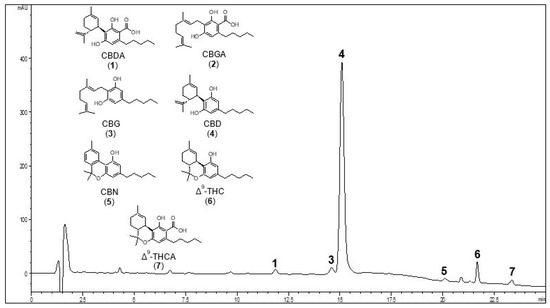
“Compounds present in Cannabis sativa L. preparations have recently attracted much attention in the treatment of drug-resistant epilepsy. Here, we screened two olive oil extracts from a non-psychoactive C. sativa variety, fully characterized by high-performance liquid chromatography and gas chromatography. Particularly, hemp oils with different concentrations of terpenes were administered at the same dose of cannabidiol (25 mg/kg/day orally), 1 h before the 6-Hz corneal stimulation test (44 mA). Mice were stimulated once a day for 5 days and evaluated by video-electrocorticographic recordings and behavioral analysis. Neuronal activation was assessed by FosB/ΔFosB immunoreactivity. Both oils significantly reduced the percentage of mice experiencing convulsive seizures in comparison to olive oil-treated mice (p < 0.050; Fisher’s exact test), but only the oil enriched with terpenes (K2) significantly accelerated full recovery from the seizure. These effects occurred in the presence of reduced power of delta rhythm, and, instead, increased power of theta rhythm, along with a lower FosB/ΔFosB expression in the subiculum (p < 0.050; Duncan’s method). The overall findings suggest that both cannabinoids and terpenes in oil extracts should be considered as potential therapeutic agents against epileptic seizures and epilepsy.”
https://pubmed.ncbi.nlm.nih.gov/34959660/
https://www.mdpi.com/1424-8247/14/12/1259


 “The Endocannabinoid System (ECS) is primarily responsible for maintaining homeostasis, a balance in internal environment (temperature, mood, and immune system) and energy input and output in living, biological systems.
“The Endocannabinoid System (ECS) is primarily responsible for maintaining homeostasis, a balance in internal environment (temperature, mood, and immune system) and energy input and output in living, biological systems.  “Background and purpose:
“Background and purpose: 
 “Voltage-gated sodium channels are targets for a range of pharmaceutical drugs developed for treatment of neurological diseases.
“Voltage-gated sodium channels are targets for a range of pharmaceutical drugs developed for treatment of neurological diseases. “Pharmaceutically purified oral cannabidiol (CBD) has been recently approved by the US Food and Drug Administration and European Medicines Agency as treatment of seizures associated with Dravet syndrome (DS) and Lennox-Gastaut syndrome (LGS), which are severe and difficult-to-treat developmental and epileptic encephalopathies with onset in early childhood.
“Pharmaceutically purified oral cannabidiol (CBD) has been recently approved by the US Food and Drug Administration and European Medicines Agency as treatment of seizures associated with Dravet syndrome (DS) and Lennox-Gastaut syndrome (LGS), which are severe and difficult-to-treat developmental and epileptic encephalopathies with onset in early childhood. “In recent years there has been a growing appreciation by regulatory authorities that cannabis-based medicines can play a useful role in disease therapy.
“In recent years there has been a growing appreciation by regulatory authorities that cannabis-based medicines can play a useful role in disease therapy. “Highly purified cannabidiol (CBD) has demonstrated efficacy with an acceptable safety profile in patients with Lennox-Gastaut syndrome or Dravet syndrome in randomized, double-blind, add-on, controlled phase 3 trials.
“Highly purified cannabidiol (CBD) has demonstrated efficacy with an acceptable safety profile in patients with Lennox-Gastaut syndrome or Dravet syndrome in randomized, double-blind, add-on, controlled phase 3 trials. “Mutations in SYNGAP1 are associated with developmental delay, epilepsy, and autism spectrum disorder (ASD). Epilepsy is often drug-resistant in this syndrome with frequent drop attacks.
“Mutations in SYNGAP1 are associated with developmental delay, epilepsy, and autism spectrum disorder (ASD). Epilepsy is often drug-resistant in this syndrome with frequent drop attacks.